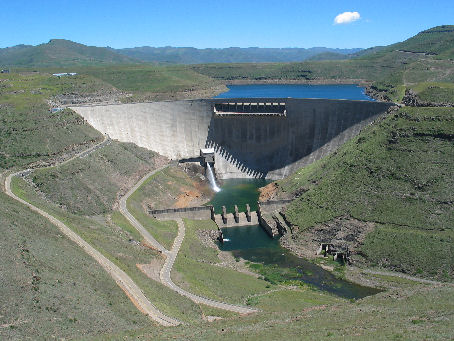2. Water Management
Water Storage
Dams are not only created in order to control the speed at which the water flows, but also to withhold water in a reservoir during rainy periods, and then make it available during dry periods.
During the 1950s, the rapid growth of the urban areas in South Africa, increased the demand for fresh water. At the same time Lesotho has been importing electricity from South Africa. In the 1980s, the plan was conceived for the creation of the Katse Dam in the Malibamat'so River, adressing both issues.
The dam was completed in May 1997 and rainfall filled the reservoir to capacity in 1998. Water flows through tunnels to the Axel river, in South Africa. At the same time, the water flow is used to generate electricity, which is used by Lesotho.
Despite the boons for both Lesotho and South Africa, there have been some negative aspcets of the dam construction. The flooding of the valleys has forced people to move and caused agricultural land to be lost. In addition, the treatment of the water, in order for it to be suitable for human consumption, meant that there is less unsilted water available for the wildlife, causing a disruprtion to the local ecosystems.
The satellite images above show the location of the Katse Dam, built on the Malibamat'so River in Lesotho (Southern Africa). The bottom image was taken in 1989, before the construction of the dam, while the top was taken in 2001 after the dam construction and the reservoir was filled with water. The lake that was formed covers and area of 38.5 km2 and contains approximately 2 billion cubic metres of water.
Satellite images can be used to frequently monitor the water levels of reservoirs. This information is very important, since it allows the authorities to have knowledge of the water availability before the drought periods.


